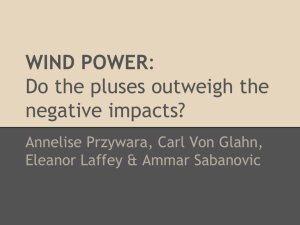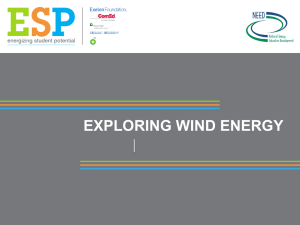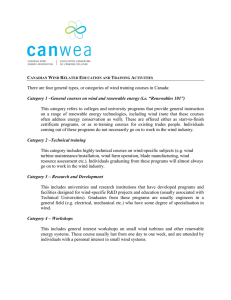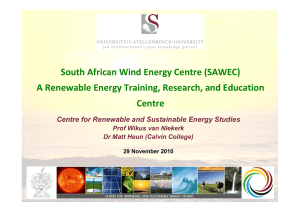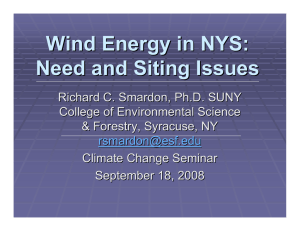PPT Slide Show
advertisement
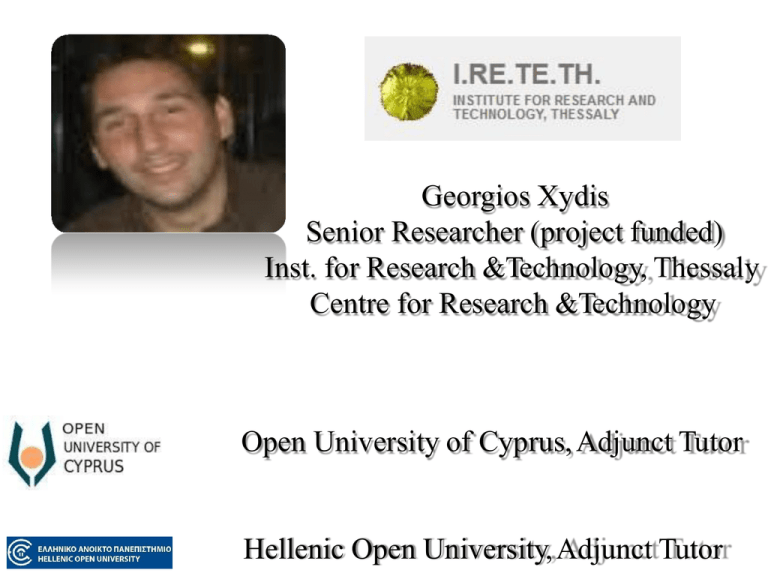
Georgios Xydis Senior Researcher (project funded) Inst. for Research &Technology, Thessaly Centre for Research &Technology Open University of Cyprus, Adjunct Tutor Hellenic Open University, Adjunct Tutor Biography George (Georgios) Xydis worked on various projects mainly in Greece that range from a single 10-kW turbine to a 486 MW offshore wind farm. He did work in the wind sector together with developers, utilities, universities, and research institutes. He holds a PhD in Engineering from National Technical University of Athens (NTUA), and a degree in Mechanical Engineering from Aristotle University of Thessaloniki. He used to work as a Wind Projects Development Coordinator at Rokas Renewables – Iberdrola Renewables, as a Wind Project Developer (Wind Resource & Siting Engineer) at Vector Hellenic Windfarms S.A., and as a Researcher (eq. Assistant Professor level) in the Center for Electric Power and Energy (CEE), Department of Electrical Engineering at Technical University of Denmark. He now runs his Energy Research and Applications company (www.xydis.gr/gr) and collaborates with Hellenic Open University and the Open University of Cyprus as an adjuct tutor, with the Centre for Research and Technology Hellas as a Senior Researcher (project funded), with the Technological Education Institute of Piraeus, and with various SMEs in the fields of Wind Resource Assessment, Energy Resources Optimization and Spatial Planning, Demand Side Management Strategies, Smart Cities, and Exergy Analysis. Research Interests • Wind Resource Analysis; Energy Analysis; Energy Resources and Spatial Planning; Demand Side Management Strategies; Resource Use Efficiency and Sectorial Analysis; Urban Planning and Built Environment. RECENT PUBLICATIONS • EA Nanaki, CJ Koroneos, GA Xydis, D Rovas (2014) Comparative environmental assessment of Athens urban buses—Diesel, CNG and biofuel powered. • G. Xydis, E.A. Nanaki, C.J. Koroneos (2014) Comparative wind farm planning on a high plateau: Dust dispersion as a sitting constraint. • G Xydis (2013) Comparison study between a Renewable Energy Supply System and a super grid for achieving 100% from renewable energy sources in Islands. • C. Koroneos, G. Xydis, A. Polyzakis (2013) The Optimal use of Renewable Energy Sources—The Case of Lemnos Island. • G Xydis, E Nanaki, C Koroneos (2013) Energy analysis of biogas production from a municipal solid waste landfill. • G Xydis (2013 Wind energy to thermal and cold storage—A systems approach. • G. Xydis (2013) The wind chill temperature effect on a large-scale PV plant—an energy approach. • George Xydis (2013)A techno-economic and spatial analysis for the optimal planning of wind energy in Kythira island, Greece. • George A Xydis, Evanthia A Nanaki, Christopher J Koroneos (2013) Lowenthalpy geothermal resources for electricity production:A demand-side management study for intelligent communities. • G Xydis (2012) Development of an integrated methodology for the energy needs of a major urban city: The case study of Athens, Greece. • G Xydis (2012) Wind-direction analysis in coastal mountainous sites: An experimental study within the Gulf of Corinth, Greece. • Christopher J Koroneos, Evanthia A Nanaki, George A Xydis (2012) Sustainability Indicators for the Use of Resources—The Energy Approach. What do wind energy systems provide? • Electricity for …but also… – Central-grids – Support for weak grids – Isolated-grids – Reduced exposure to energy price volatility – Remote power supplies – Water pumping – Reduced transmission and distribution losses Wind Resource • High average wind speeds are essential – 4 m/s annual average is minimum – People tend to overestimate the wind – Wind speed tends to increase with height • Good resource – Coastal areas – Crests of long slopes – Passes – Open terrain – Valleys that channel winds • Typically windier in – Winter than summer – Day than night Advantages of Wind Power • Environmental • Economic Development • Fuel Diversity & Conservation • Cost Stability Technology Turbine Evolution Used for • Pumping water • Grinding grain Mainly used for • Generating Electricity Types of turbines VAWT Drag is the main force Nacelle is placed at the bottom Yaw mechanism is not required Lower starting torque Difficulty in mounting the turbine Unwanted fluctuations in the power output HAWT Lift is the main force Much lower cyclic stresses 95% of the existing turbines are HAWTs Nacelle is placed at the top of the tower Yaw mechanism is required Offshore Turbines More wind speeds Less noise pollution Less visual impact Difficult to install and maintain Energy losses due long distance transport Future Wind Turbines Wind Amplified Rotor Platform World’s First Airborne Wind Turbine To Bring Renewable Energy and WiFi Disc type wind turbine • Much more efficient than HAWT • Requires less height • Low noise • Works in any wind direction E-signature ========== George Xydis, PhD Senior Researcher (project funded) Institute for Research & Technology-Thessaly(I.RE.TE.TH.)/ Centre for Research & Technology Hellas (CE.R.T.H.) Technology Park of Thessaly, 1st Industrial Region, P.O. Box 15, 38500 Volos, Greece e-mail: gxydis@mail.ireteth.certh.gr, gxydis@gmail.com ============================================== OMICS International Open Access Membership enables academic and research institutions, funders and corporations to actively encourage open access in scholarly communication and the dissemination of research published by their authors. For more details and benefits, click on the link below: http://omicsonline.org/membership.php OMICS GROUP OPEN ACCESS MEMBERSHIP






